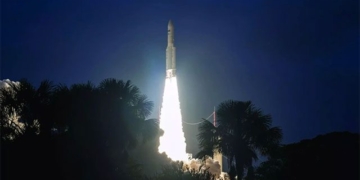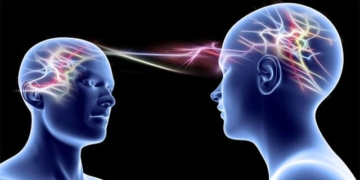Earth – our planet, unlike what we see today, began its life as a terrifying sphere that even the most gruesome scenes in movies cannot compare to. So, what has led to the emergence of life and civilization as we know it?
With the modern model of the Solar System and the discovery of the oldest rock samples on Earth, which are over 4 billion years old (4.03 billion years in Canada and 4.4 billion years in Western-Central Australia), scientists today have concluded that Earth formed about 4.7 billion years ago, a result of the gravitational attraction of millions of large and small rock fragments, dust, and gas within a band of material orbiting the Sun.
Initially, Earth was just a hot, lifeless planet, with heavy metals sinking and melting into its core, pushing lighter materials upwards and cooling gradually. At this time, Earth took the form of a massive black sphere with bright cracks formed by the molten material within. These cracks would continue to exist for billions of years, often becoming a decisive factor for the survival of life on the planet.
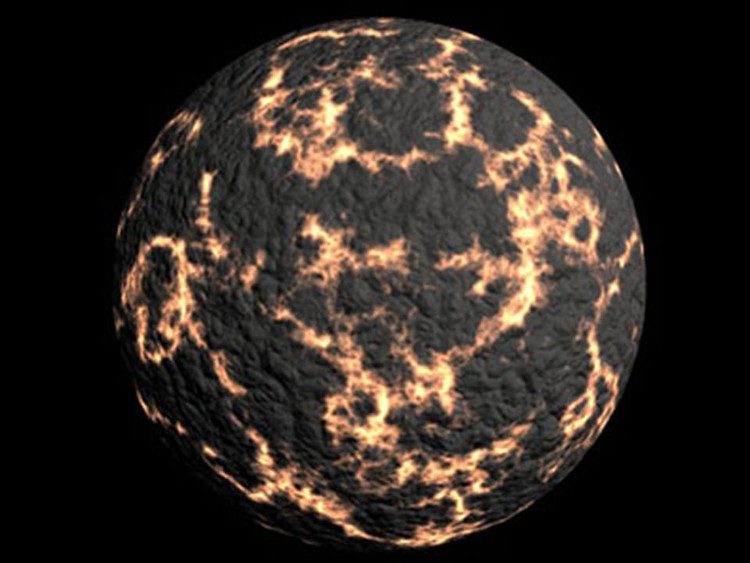
Initially, Earth was just a hot, lifeless planet.
4.3 billion years ago, a planet the size of Mars named Theia (which formed during the early stages of the Solar System) approached Earth. The collision was a true disaster, but it was also a prerequisite for life as we know it today. First, it made the density of material on Earth more uniform, similar to shaking a jar filled with various candies. Next, it formed the Moon. Material from the surfaces of both planets was ejected into space, creating a ring of material in orbit around Earth, similar to the rings of Saturn and other large planets today. Gravitational forces once again played the role of creator, gathering the debris to form the Moon.
At this point, the Moon was very close to Earth, and Earth was spinning rapidly. If things had continued this way, life would have struggled to form. However, thanks to the presence of the Moon, Earth gradually slowed its rotation due to gravitational effects, while centrifugal force pushed the Moon further away, preventing us from experiencing tidal waves far stronger than the worst tsunamis we see today. This was around 4.1 billion years ago when oceans and an atmosphere (lacking oxygen) were forming.
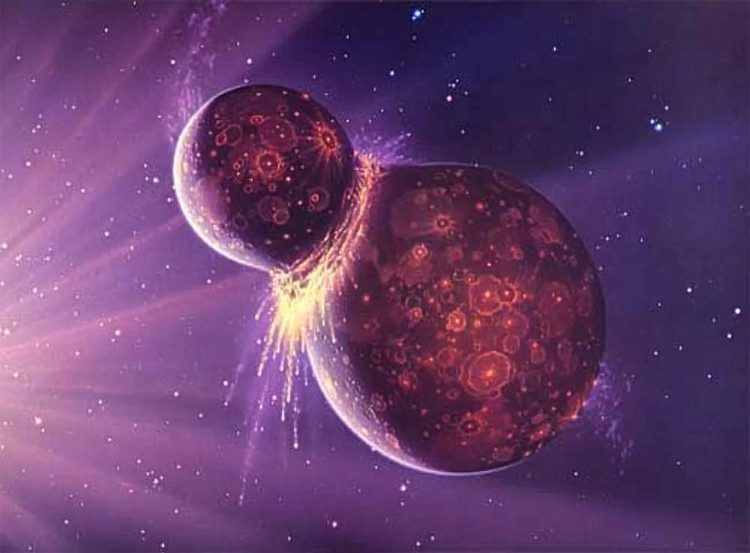
A planet the size of Mars named Theia collided with Earth.
Approximately 4.1 to 3.8 billion years ago, Earth was filled with oceans as its cooling allowed the existence of liquid water. Small asteroids and meteoroids continuously bombarded Earth, remnants from the early days of the Solar System. These meteoroids brought hydrated crystals and even the simplest organic compounds into the oceans, where life would eventually arise.
3.8 billion years ago, Earth entered the Archaean eon. This was the middle stage of the pre-Cambrian period. From the first organic compounds delivered by meteoroids striking Earth, amino acids formed in the oceans, leading to the development of the simplest cells. Unlike today, these were based on RNA (Ribonucleic Acid), as opposed to DNA (Deoxyribonucleic Acid) that modern plants and animals are made of. Today, we have found fossils of the earliest life forms dating back 3.5 billion years. The first cells were unicellular organisms that gradually combined into thicker layers known as stromatolites, the first life forms to engage in photosynthesis, supplying oxygen to our planet. The first simple glucose compound (sugar) also formed.
3 billion years ago, oceans became filled with oxygen, iron in the oceans oxidized and sank to form iron ore, the very materials we use for construction today are made from this 3 billion-year-old ore.
2.5 billion years ago, the Proterozoic eon began. This marked the initial development of primitive life forms on Earth, the final stage of the pre-Cambrian period. The first multicellular plants appeared around 1.2 billion years ago with a more complex structure based on DNA instead of RNA as before.
However, the development of life did not last long before it was forced to halt. Time seemed almost to stop as Earth entered the longest and most intense period of global freezing in history. 850 million years ago, an excessively high density of oxygen in the atmosphere prevented sunlight from being absorbed, causing Earth to cool and gradually freeze. The more ice there was, the more sunlight was reflected back into space, as the entire planet acted like a huge mirror, absorbing no light whatsoever.
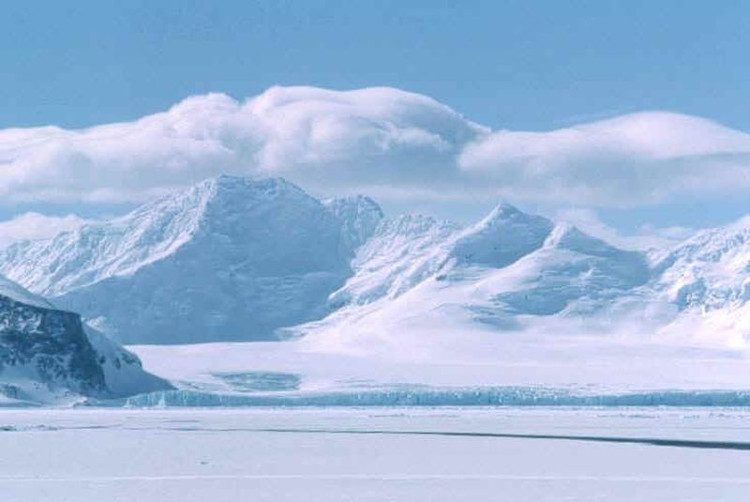
Earth was a giant ice sphere with no traces of life.
This period lasted for over 200 million years. We know that modern humans, with a history that seems quite long, actually only emerged with true civilization and intelligence at the end of the Ice Age, around 15,000 to 20,000 years ago. In contrast, the global freezing period lasted over 200 million years. Earth was a giant ice sphere, devoid of any signs of life or warmth from the Sun, with any rays from the Sun reflected back into space.
630 million years ago, molten lava deep within the Earth was awakened, becoming the savior of life on the planet. Volcanoes, having been dormant for hundreds of millions of years, erupted, breaking through some ice caps on the Earth’s surface, spewing lava and, most importantly, carbon dioxide. As we know, carbon dioxide is a key factor in causing the greenhouse effect, and at this moment, it became the savior of life on Earth. The atmosphere absorbed the Sun’s heat, and the volcanic eruptions caused the ice to melt, creating conditions for the deepest forms of life in the ocean to evolve. This melting process lasted for several million years.
580 million years ago, multicellular plants became quite common, and this was also the first period of soft-bodied animals, with fossils of these creatures dating back to this time.
540 million years ago, oxygen continued to fill the atmosphere, and the upper layer of the atmosphere began to receive sunlight, forming a layer of ozone from oxygen, which blocked ultraviolet radiation from penetrating the atmosphere, thus creating conditions for life to invade land (as the first landmasses appeared).
Around 530 million years ago, Earth entered the Paleozoic era, starting with the Cambrian period. This was a time of explosive biological development, lasting about 30 million years, known as the Cambrian explosion. Under the sea, more complex animals appeared, notably trilobites and their relatives. Additionally, this was the first appearance of predatory animals, which directly attacked other species for food instead of consuming small plants or floating carcasses. For example, the image below shows an Anomalocaris preparing to attack its prey, a trilobite.
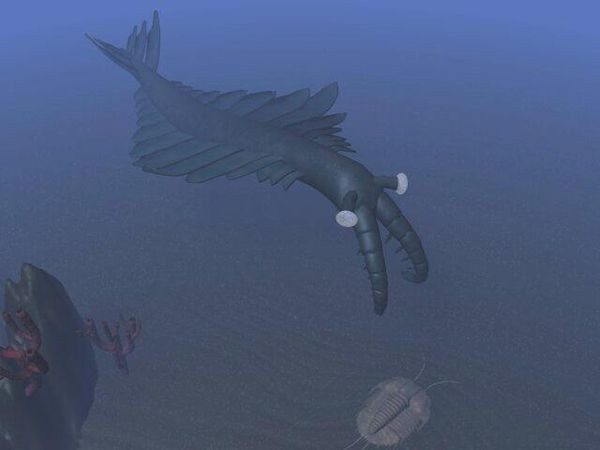
The Anomalocaris.
505 million years ago, the next phase of plant and animal development began, marking the second period of the Paleozoic, the Ordovician period. The oceans covered the entire northern part of Earth, and biological development was concentrated on the southern continent known as Gondwana. This was a time of significant growth for soft-bodied organisms and especially the explosion of fish species. The first fish appeared and dominated the oceans from this period until the Silurian (440-410 million years ago) and Devonian (410-360 million years ago).
The Devonian Period, 410 million years ago, saw a species of fish known as Tetrapods making contact with land and gradually using their fins to crawl up. After millions of years of evolution, they fully emerged onto land, evolving into the first terrestrial animals, followed by the species Ichthyostega. Additionally, this was a time of significant development for insect species that resemble modern-day insects, such as dragonflies and various arthropods, but with much larger sizes. Not only that, plant species also thrived, growing to gigantic sizes, reaching heights of several meters due to the high concentration of oxygen in the atmosphere.
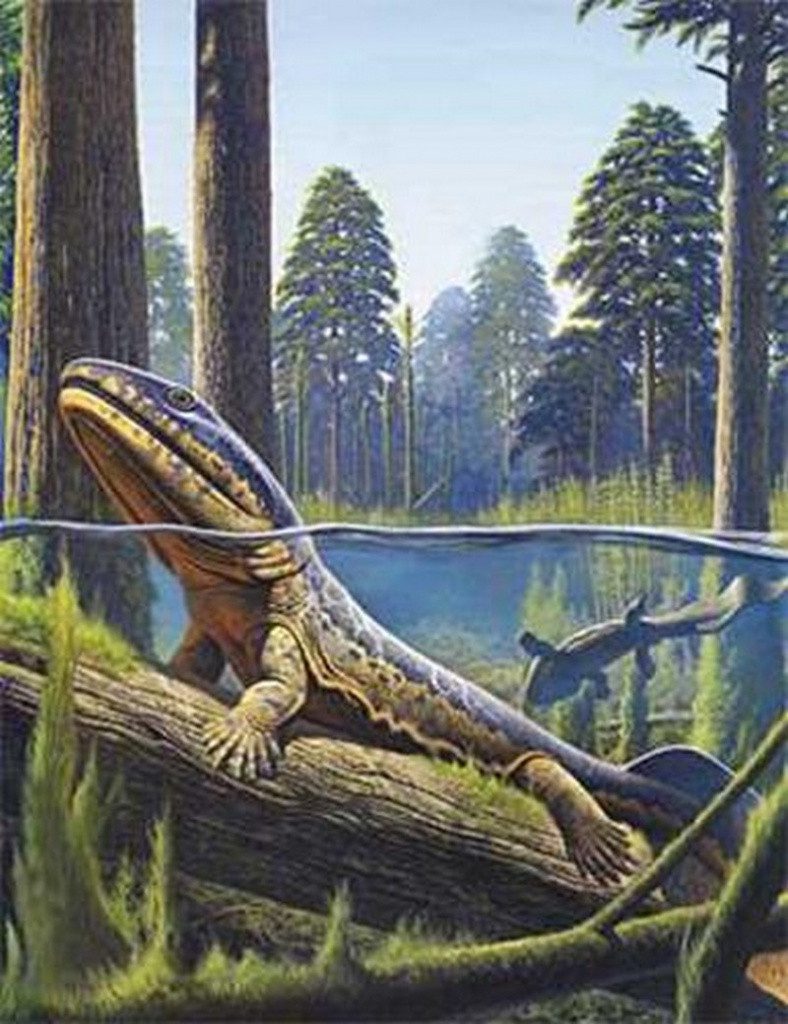
A fish known as Tetrapods.
From 360 million to 286 million years ago, during the Carboniferous Period (also known as the Coal Age). This era witnessed a series of plant die-offs, which eventually formed coal deposits that we see today. Most importantly, this was the period when animals began laying eggs on land. It is essential to note that prior to this Carboniferous phase, even species that started to invade the terrestrial world, such as certain reptiles and amphibians, still had the habit of laying eggs in water, as the embryos required moisture to survive until birth. However, by this period, reptiles had evolved to lay eggs that contained water to directly sustain the embryos. The first two ancestors of later reptilian generations were Hylonomus and Paleothyris.
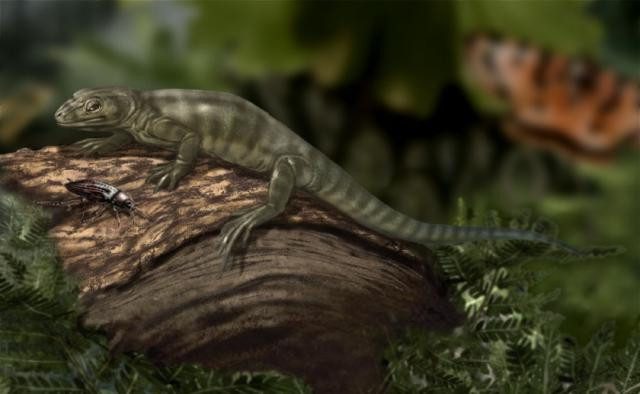
A Hylonomus.
Large trees died, forming coal, while a new generation of equally massive plants appeared, including mosses that reached heights of 30 meters, horsetails, and ferns that grew over 15 meters tall, thriving across the continent of Gondwana.
From 286 to 248 million years ago, Earth entered the final phase of the Paleozoic Era, known as the Permian Period. This was a critical time in the development of animals. Some reptiles evolved into the early stages of mammals, such as the therapsids shown below, which evolved from the species Dimetrodon. They had facial structures and teeth very similar to modern mammals and were among the most fearsome predators of the Permian period. However, it is unfortunate that mammalian development did not progress smoothly; therapsids and many other species (primarily reptiles) of that time fell victim to the most catastrophic extinction event in Earth’s history: the Permian-Triassic Extinction.
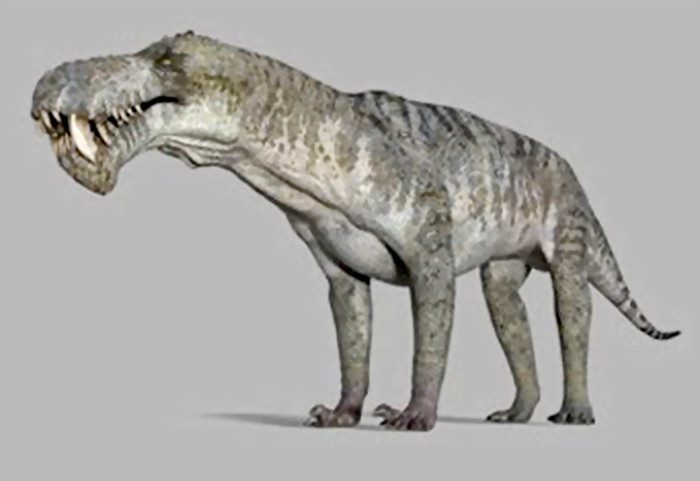
Therapsids.
To this day, there are still many differing opinions regarding the cause of this disaster, but the majority believe that the mass extinction was due to the merging of the two continents, Laurasia and Gondwana, into the supercontinent Pangaea. This collision disrupted the landscapes of both large continents, leading to earthquakes and volcanic activity on a continental scale that devastated living organisms. However, the worst devastation occurred among oceanic species, with up to 95% of species permanently disappearing after this extinction event.
This mass extinction marked the end of the Permian period and transitioned into the next era known as the Mesozoic Era.
248 million years ago marked the beginning of the Mesozoic Era, following the end of the mass extinction. Both in the oceans and on land, changes ceased, but the natural conditions were no longer as they had been, and some species adapted better than others, evolving to become the dominant life forms on Earth. The first period of the Mesozoic is the Triassic Period (often referred to as the Triassic in some Vietnamese literature), which marks the beginning of what is referred to as the Age of Dinosaurs. This was the most prosperous era in the history of reptiles. The ancestors of mammals, such as the Cynodonts, continued to survive and set the stage for the mammalian explosion that ultimately led to our existence.
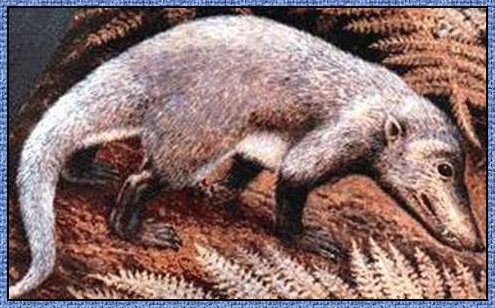
Cynodonts.
However, during the Triassic, mammals and fish were significantly overshadowed by the dominance of dinosaurs. They appeared everywhere, ranging in size from small to large, and in various forms. While in the depths of the ocean, Ichthyosaurs and Nothosaurs ruled for an extended period, on land, dinosaurs thrived even more. They were categorized into three main groups: theropods (predatory species like T-rex, Coelophysis, and Allosaurus), sauropods consisting of long-necked dinosaurs like Apatosaurus and Mamenchisaurus, and finally the ornithischians which included species like Triceratops (the three-horned dinosaur), Stegosaurus (the armored dinosaur), and even Iguanodons, as seen in the famous Disney film Dinosaur. The image below features a T-rex (Tyrannosaurus Rex), the most famous predatory dinosaur of the Triassic period.
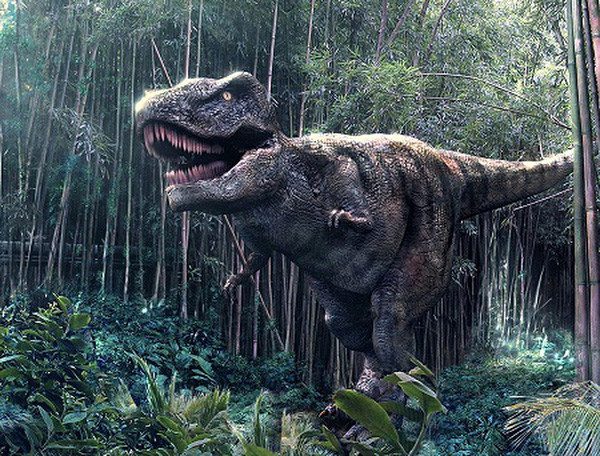
Tyrannosaurus Rex.
213 million years ago, the Jurassic Period began. This is the middle phase of the Mesozoic Era. Pangaea once again split into Laurasia and Gondwana. Within these rifts, a mass extinction of numerous species, including plants, fish, and marine animals, occurred.
These remnants sank and formed today’s oil deposits, marking a significant point in Earth’s geological history and contributing greatly to our modern world.
Meanwhile, on land, reptiles continued to evolve. By the middle of the Jurassic period, they dominated the air, land, and oceans, with a significantly increased number of species compared to the Triassic period. In the oceans, the plesiosaurs emerged and ruled the seabed.
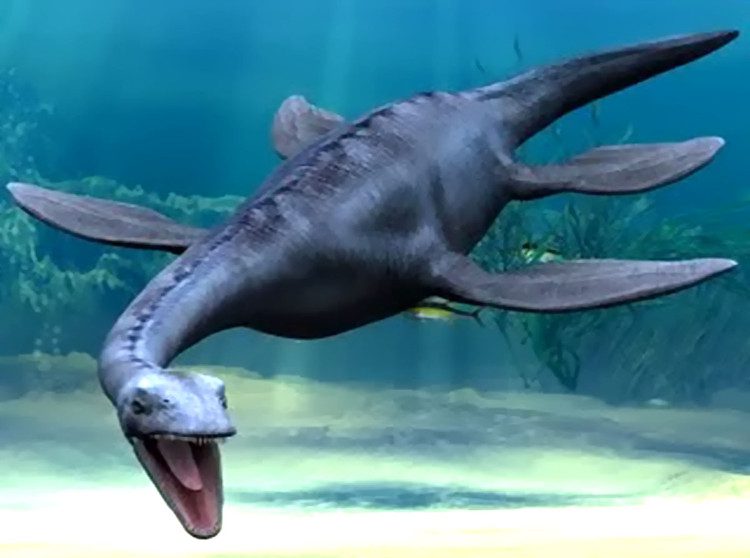
A Plesiosaur.
In the skies, pterosaurs, winged lizards, dominated. However, they were not the ancestors of modern birds. Birds began to emerge during the Jurassic period, evolving from a carnivorous dinosaur that developed feathers, becoming a transitional species between reptiles and birds. The Archaeopteryx is considered the ancestor of modern birds.
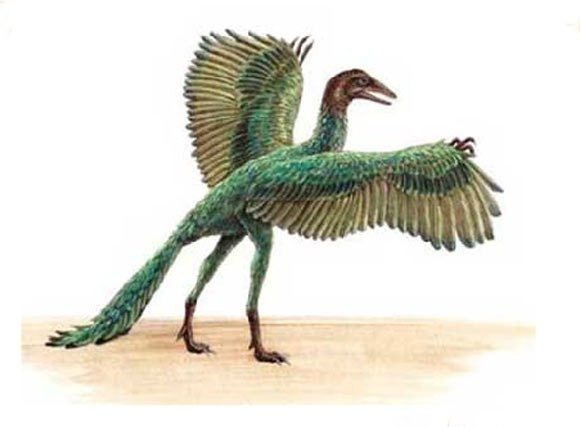
The Archaeopteryx – ancestor of modern birds.
Mammals during this period were merely small creatures akin to today’s mice, forced to live in hiding to escape the predation of dinosaurs.
145 million years ago, Earth transitioned into the Cretaceous Period (often referred to as the Chalk Age in some Vietnamese literature), marking the final phase of the Age of Dinosaurs and the last period of the Mesozoic Era.
The most notable point of this period was the emergence of flowering plants, which were pollinated by insects, replacing the older generation of plants, primarily ferns and conifers. Dinosaurs did not thrive as before due to the changing vegetation. However, they remained the undefeated rulers until about 65 million years ago.
The majority of current opinions lean towards the hypothesis of a catastrophic asteroid impact, supported by evidence of iridium (a substance that can only come from outer space) with an age of about 65 million years found in Central America, in the region of the Gulf of Mexico. This hypothesis suggests that an asteroid with a diameter of over 10 kilometers in the Solar System collided with Earth. This catastrophic impact created what is now the Gulf of Mexico and triggered the largest tsunami and earthquakes throughout the entire Mesozoic Era.
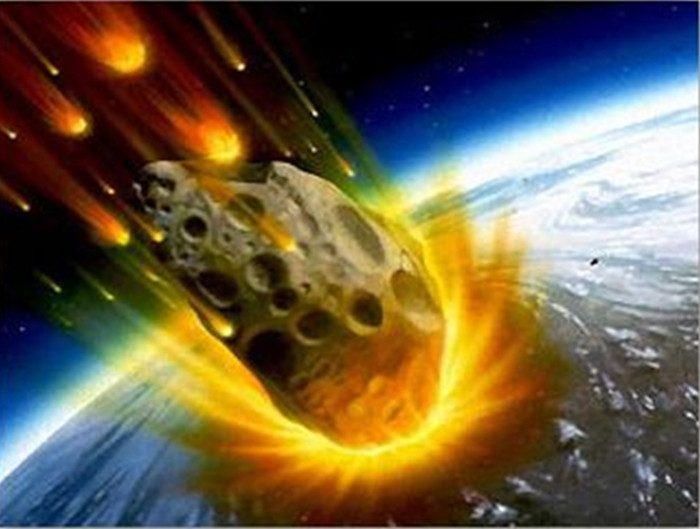
An asteroid with a diameter of over 10 kilometers in the Solar System hurtled towards Earth.
More importantly, it caused significant climatic shifts. Volcanic eruptions, along with meteorite impacts, resulted in mass fatalities of large animal species. Ash and soot from volcanic eruptions and impacts covered the sky, blocking sunlight from reaching the surface, leading to a massive die-off of plant species. The depletion of food sources along with sudden temperature changes were the most critical factors contributing to the extinction of the dinosaurs.
However, in terms of scale, this collision event cannot compare to the Permian mass extinction. This is why some small reptiles and bird species survived due to their lower food requirements, as well as their ability to easily hide from the impacts of the catastrophe. Most importantly, our mammalian ancestors endured the disaster to enter the next stage of Earth’s history.
The Cenozoic Era
A world devoid of dinosaurs remained sparse for a long time as birds had not yet developed strongly and mammals were accustomed to hiding in deep burrows to avoid dinosaurs. It wasn’t until nearly 60 million years ago that mammals emerged from their shelters and diversified into many forms, from predators to prey, with formidable enemies at that time being gigantic predatory birds.
About 55 million years ago, at the end of the Paleocene epoch (part of the Cenozoic), primates began to appear in tropical and subtropical regions, exhibiting characteristics that allowed them to adapt to their environment: front feet (later evolved into hands) with five fingers, including an opposable thumb for grasping and climbing; a flexible neck that allowed observation from multiple angles… These were the first ancestors of modern humans.
During the Eocene epoch, immediately following the Paleocene, from 55 to 33.7 million years ago, the climate warmed, and tropical forests expanded from the equator while ice was concentrated in the polar regions, especially Antarctica. This period saw the emergence of many plant and animal species similar to those of today, notably hoofed animals and some primate species that were closer to us.
Notably, during this period, two groups of hoofed animals flourished: Artiodactyla (ancestors of modern deer) and Perissodactyla (ancestors of horses and rhinoceroses). Horses at that time were quite small, comparable to small dogs today. Later, they gradually went extinct, leaving only a few survivors that evolved into today’s horses, zebras, and rhinoceroses.
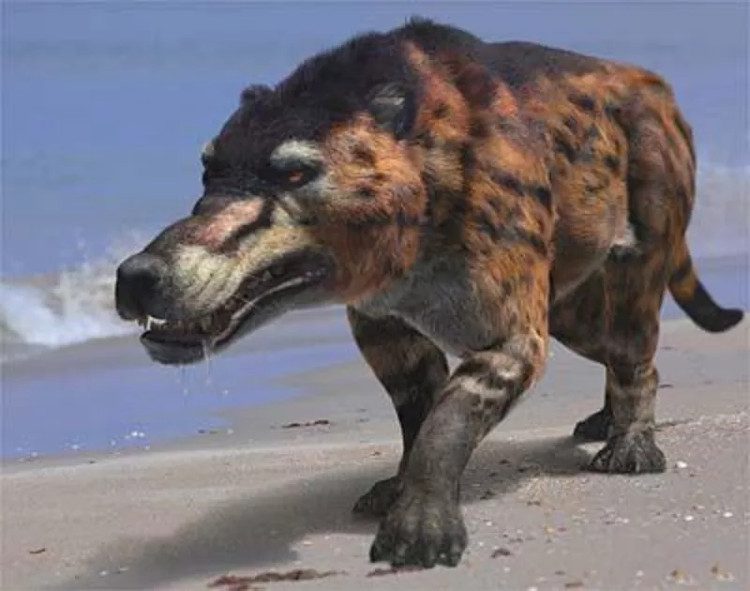
Mesonychids.
Another significant and noteworthy branch in the history of life is the Mesonychids, which resembled modern-day dogs and hyenas. They were the predators of over 30 million years ago. Due to their favorable adaptation to aquatic environments, they left the land, gradually adapting to a new habitat, eventually evolving into today’s whales.
The true close ancestors of humans appeared around 3.7 million years ago, which is the furthest point at which we can currently trace the footprints of hominids capable of walking on two legs. This species, named Australopithecus, thrived in the forests of Africa. The desertification of this continent transformed forests into deserts or grasslands, eliminating trees to climb, prompting Australopithecus to evolve to adapt to a life without treetops.
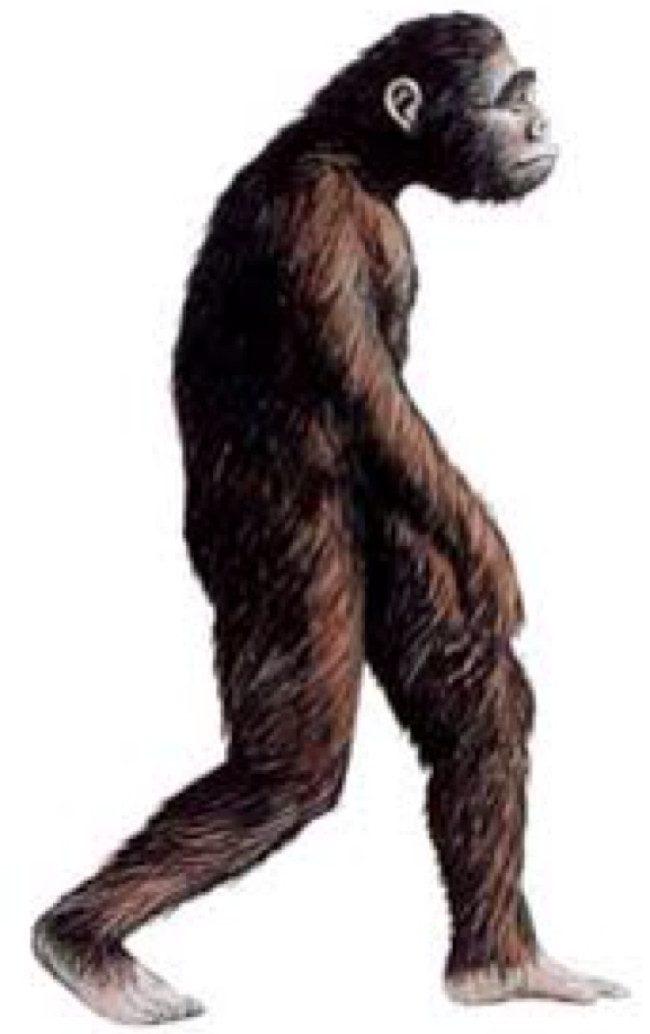
Australopithecus – close ancestor of humans.
Australopithecus later evolved into Homo habilis, which bore a closer resemblance to modern humans, and then further into Homo ergaster, followed by Homo erectus, which had less body hair, primarily concentrated on the head, with bodily functions quite similar to those of modern humans.
Homo erectus is believed to be the first human-like ancestor of modern humans, with a brain size about 74% that of contemporary humans, existing around 1.8 million years ago.
It wasn’t until about 100,000 years ago that our first intelligent species truly emerged, known as Homo sapiens. They represent the most intellectually advanced branch among the generations of hominid species. With the desertification of Africa, they crossed the borders between Africa and Europe, spreading across Europe and Asia (initially the Middle East) and coexisting with strange animals during the Ice Age, such as Mammoths and other mammals that exhibited various differences from today’s animals.
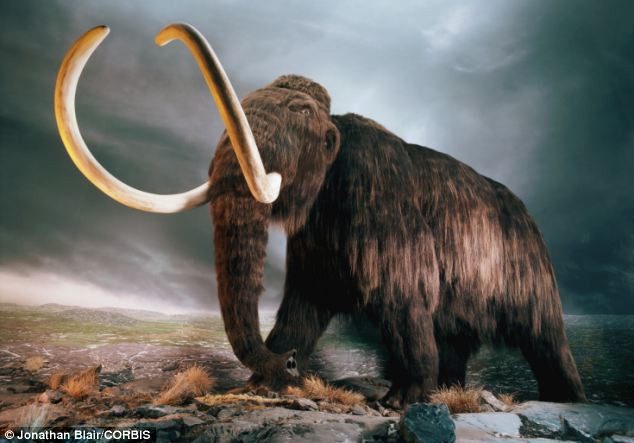
Mammoth.
As the Ice Age entered its final phase around 12,000 years ago, humans truly stepped into their era, forming social organizations from small to large, from simple to complex. While dinosaurs were the longest-dominant species on this planet throughout its history, humans have occupied it for a remarkably short time but have developed at an astonishing rate in terms of population, societal development, and technological advancement. What we have today, including the very lines you’ve just read, is the result of this entire process!
Đặng Vũ Tuấn Sơn



















































